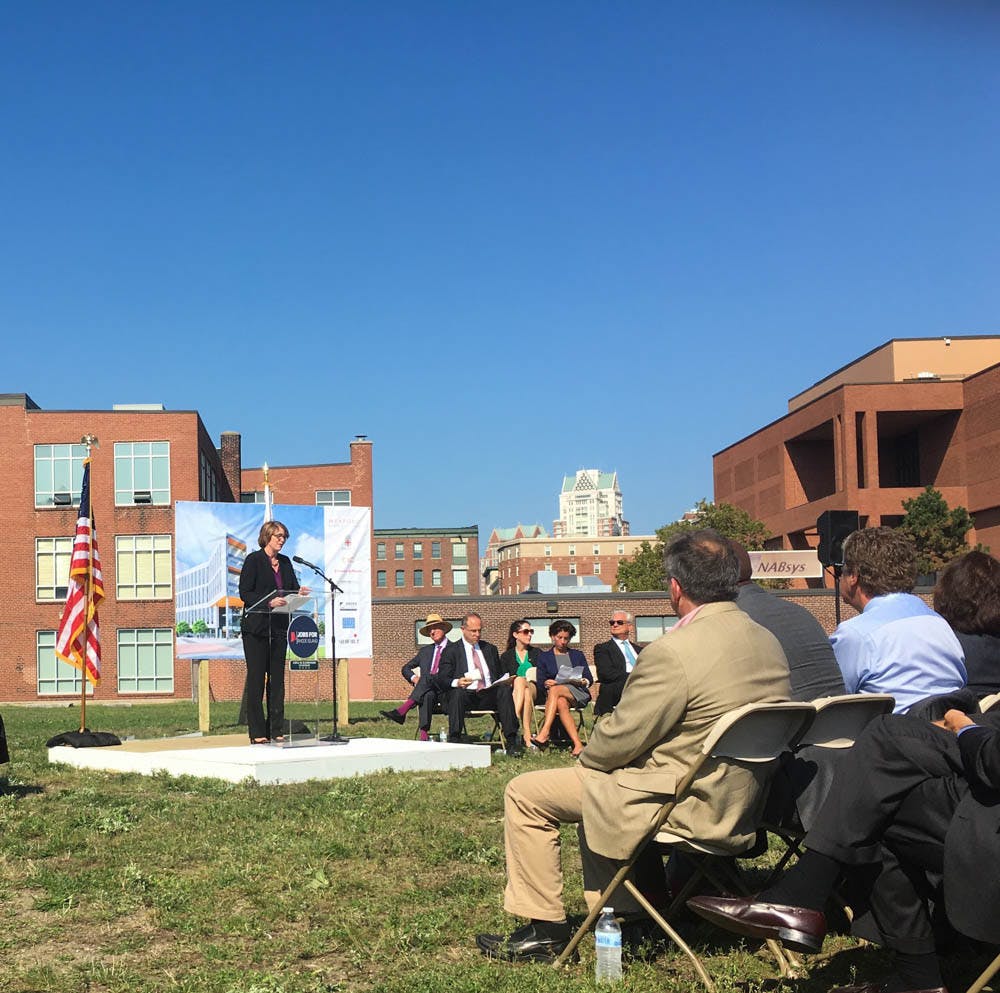I-195 land parcels in the Jewelry District were the site of a groundbreaking yesterday morning, where Gov. Gina Raimondo, President Christina Paxson P’19 and several state officials symbolically began construction for the Wexford Innovation Center.
The Innovation Center, a 191,000 square-foot facility funded in part by Wexford Science & Technology, LLC, will include 50,000 square feet for the School of Professional Studies, for which the University signed a 15-year lease. Dean of the School of Professional Studies Karen Sibley MAT’81 P’07 P’12 P’17 told The Herald this space will enable the School of Professional Studies to expand its programs and build a relationship with the Cambridge Innovation Center, another tenant in the complex.
The Cambridge Innovation Center rents “spaces to people who need a place to be where they can thrive with other like-minded people, and what (the School of Professional Studies does) is offer educational content that helps people of that sort develop their ideas further and have a better grounding in order to deploy new enterprise all over the world,” Sibley said.
In remarks at the ceremony, Paxson said the School of Professional Studies’ presence in the new complex will enhance the University’s ability to innovate.
“We can leverage the talent that we have at Brown in new, different and very compelling ways, and when I look at our (faculty, researchers and students), they’re working in exactly the kind of areas where innovation is most needed and is growing in different parts of the country,” Paxson said.
The School of Professional Studies’ current site at 200 Dyer St. is not large enough to accommodate having more than one of the school’s programs on campus at once. Though this problem does not prevent the School of Professional Studies from functioning effectively, the new space will enable different groups of students to interact and increase room for faculty, Sibley said.
“We’d like to bring everyone under one roof, and the new building will enable us to do that,” Sibley said.
In addition to bolstering the University’s programs, this complex marks an important step in growing the state’s economy, Raimondo said to those in attendance. “A few key projects like this one will be catalytic in moving this state forward to the 21st-century economy and underpinning that economy,” Raimondo said.
Raimondo projects that around 1,000 jobs will be created in the process of constructing the complex, which should be built in two years. Of the jobs created, 675 will be directly or indirectly related to construction, according to Rolfe.
“A couple of years ago, the unemployment in the building trades was in the teens,” Raimondo said. “We talked to these guys, they were losing their houses, they were out of work for a year at a time.”
“This innovation complex is going to be a space for exactly the kind of jobs the governor has been working to create and foster,” Catherine Rolfe, deputy press secretary for Raimondo, told The Herald.
For more than two decades, the state has been working to relocate portions of I-195, said Bonnie Nickerson, director of the Department of Planning and Development for Providence.
“All of that groundwork was laid to create an opportunity for economic growth and revitalization to literally pave the way to be here this morning,” Nickerson said in her speech.
I-195 had divided Downcity and the Jewelry District, according to the Jewelry District Association.
Developments like the Wexford Innovation Center and a $40 million academic building that Johnson & Wales University broke ground for in 2015 are helping to foster economic development in the area, according to the I-195 Redevelopment Commission.
“By generating economic energy, (this project) will create opportunity for residents of Providence and Rhode Island generally. What’s exciting about a catalyzing center like this is that it will create jobs at every level of every description,” Rhode Island Secretary of Commerce Stefan Pryor told The Herald. “This is an enormously important project for the economy of Rhode Island.”
Funding for the $88 million dollar Wexford Innovation Center includes around $32 million in tax dollars, according to WPRI.
Taxpayer funding can act as a necessary incentive for investors, Rolfe said. “With any large economic initiative, unfortunately, to compete, Rhode Island has to stay in the game by offering some kind of incentive,” she added. “The governor’s committed to doing everything she can to keep Rhode Island competitive while balancing financial interests.”
Representatives from Rhode Island’s state and federal delegations, members of the I-195 Redevelopment Commission and officials from the University expressed optimism about the economic advancements and academic innovations that this complex could help spark.
“Experiments like this, if you navigate them effectively, they can lead to even more positives than you imagine at the outset,” Sibley said.





